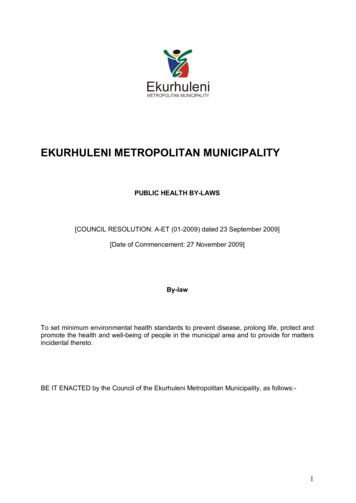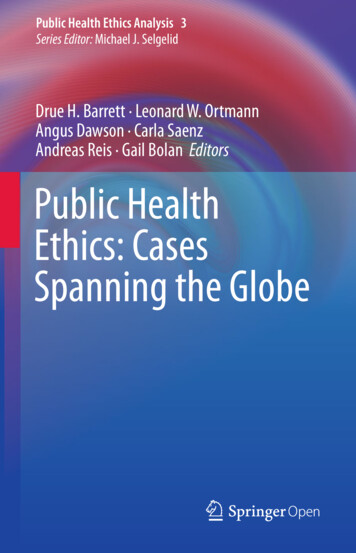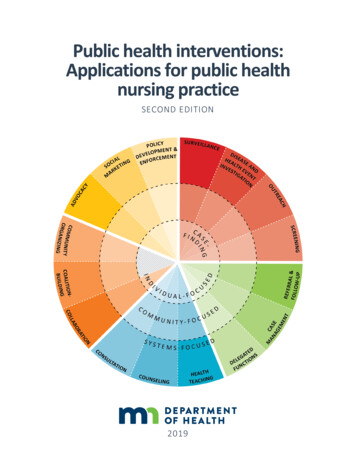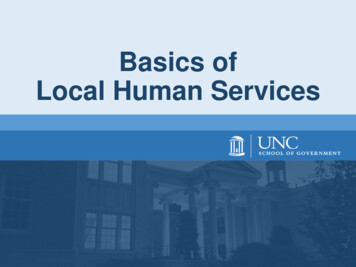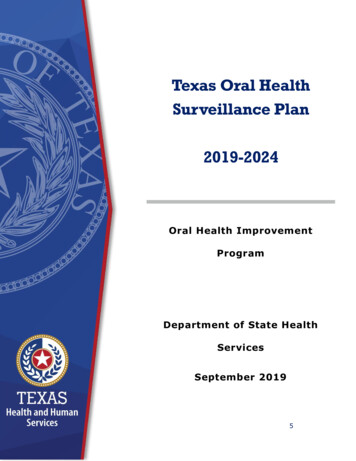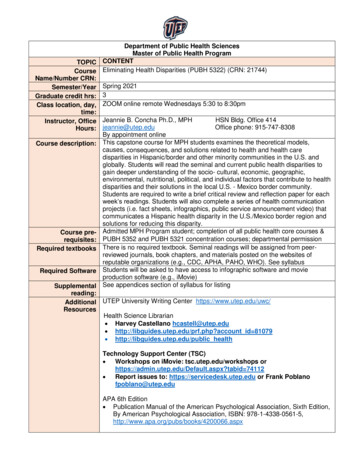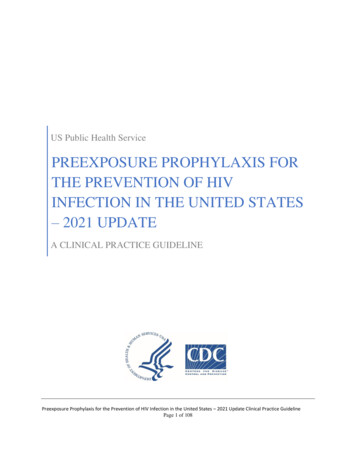
Transcription
US Public Health ServicePREEXPOSURE PROPHYLAXIS FORTHE PREVENTION OF HIVINFECTION IN THE UNITED STATES– 2021 UPDATEA CLINICAL PRACTICE GUIDELINEPreexposure Prophylaxis for the Prevention of HIV Infection in the United States – 2021 Update Clinical Practice GuidelinePage 1 of 108
What’s New in the Preexposure Prophylaxis for the Prevention of HIV Infection in theUnited States - 2021 Update – A Clinical Practice GuidelineThe Preexposure Prophylaxis for the Prevention of HIV Infection in the United States – 2021Update – A Clinical Practice Guideline includes revisions to several sections. These revisions areintended to update existing guidance using the current evidence base, to incorporate recent FDAPrEP medication approvals, and to clarify specific aspects of clinical care. Other revisions weremade to improve usability and increase implementation of the guideline based on commentsreceived from clinicians providing PrEP care. Minor revisions were also made to correcttypographical errors, add or update references, and update content from cited guidelines andsource materials.What’s new In anticipation of likely FDA approval of a PrEP indication for cabotegravir (CAB) in late 2021,we added a new section about prescribing PrEP with intramuscular injections of CAB every 2months for sexually active men, women, and transgender persons with indications for PrEP use.Summary (of graded recommendations) We added a recommendation to inform all sexually active adults and adolescents aboutPrEP (IIIB). We added a recommendation: PrEP with intramuscular cabotegravir (CAB) injections(conditional on FDA approval) is recommended for HIV prevention in adults reportingsexual behaviors that place them at substantial ongoing risk of HIV exposure andacquisition (IA).Table Summarizing Clinical Guidance We added a table specific for CAB (as CAB has a different dosing and recommendedfollow-up schedule than oral PrEP, and no renal or lipid monitoring is required) (Table1b).Preexposure Prophylaxis for the Prevention of HIV Infection in the United States – 2021 Update Clinical Practice GuidelinePage 2 of 108
Identifying Indications for PrEP We simplified the determination of indications for PrEP use for sexually-active persons.We replaced boxes with flow charts for assessing indications for sexually active personsand persons who inject drugs.Laboratory Tests and other Diagnostic Procedures We revised the HIV testing algorithm to provide two algorithms; one for assessing HIVstatus in persons with no history of recent antiretroviral exposure starting (or restarting)PrEP and, the other for assessing HIV status at follow-up visits while persons are taking,or have recently taken, PrEP.Providing PrEP We added F/TAF as an FDA-approved choice for sexually active men and transgenderwomen at risk of HIV acquisition; the FDA approval for F/TAF excluded persons at riskthrough receptive vaginal sex including cisgender women (persons assigned female sex atbirth whose gender identity is female). We revised and reordered the sections on initiation and follow-up care to first describeguidelines applicable to all PrEP patients and then describe guidelines applicable only toselected patients. We revised frequency of assessing eCrCl to every 12 months for persons 50 years of ageor with eCrCL 90 ml/min at PrEP initiation and every 6 months for all other patients. We added medications to Table 4 of drug interactions for TAF. We outlined options for PrEP initiation and follow-up care by telehealth (“Tele-PrEP”). We outlined procedures for providing or prescribing PrEP medication to select patients onthe same day as initial evaluation for its use (“same-day PrEP”). We outlined procedures for the off-label prescription of TDF/FTC to men who have sexwith men on a non-daily regimen (“2-1-1”) and their follow-up care. We added a brief section on primary care considerations for PrEP patients (Table 6). We added a section on providing CAB for PrEP.Evidence Review We updated the evidence review and moved it to Appendix 2. We added evidence reviews for CAB trials. We separated clinical trial results for transgender women and MSM into separate rows inevidence tables.
Revisions post FDA approval of cabotegravir injections for PrEPIt is anticipated that FDA will review and may approve cabotegravir injections for PrEP within2-3 months after the publication of this guideline. We will then post a revised version of thisguideline that replaces references to pending FDA approval with statements indicating thatapproval has been given.Disclaimers:All material in this publication is in the public domain and may be used and reprinted withoutpermission; citation as to source, however, is appreciated.References to non-CDC sites on the internet are provided as a service to readers and do notconstitute or imply endorsement of these organizations or their programs by CDC or the U.S.Department of Health and Human Services. CDC is not responsible for the content of these sites.URL addresses listed were current as of the date of publication.Use of trade names and commercial sources is for identification only and does not implyendorsement by the U.S. Department of Health and Human Services.Potential Conflicts of Interest:CDC and individual employees involved in the guideline development process are named in USgovernment patents and patent applications related to methods for HIV prophylaxis.Suggested Citation:Centers for Disease Control and Prevention: US Public Health Service: Preexposure prophylaxis forthe prevention of HIV infection in the United States—2021 Update: a clinical practice c-hiv-prep-guidelines-2021.pdf. Published XXX 2021.For More Clinical Advice About PrEP Guidelines: Call the National Clinicians Consultation Center PrEPline at 855-448-7737; Go to the National Clinicians Consultation Center PrEPline website -pre-exposure-prophylaxis/; and/or Go to the CDC HIV website for clinician resources eexposure Prophylaxis for the Prevention of HIV Infection in the United States – 2021 Update Clinical Practice GuidelinePage 4 of 108
Table of ContentsList of Tables, Figures, and Boxes .9Abbreviations (In Guideline and Clinical Providers’ Supplement) .11Summary.13Introduction .18Evidence of Need for Additional HIV Prevention Methods.21All Patients Being Assessed for PrEP Provision .22Identifying Indications for PrEP .22Assessing Risk of Sexual HIV Acquisition . 23Assessing Risk of HIV Acquisition Through Injection Practices . 26Laboratory Tests and Other Diagnostic Procedures .28HIV testing . 28Acute HIV Infection . 29Testing for Sexually transmitted Infections. 31Laboratory Tests for Patients Being Considered for Oral PrEP .32Renal function . 33Testing for Infection with Hepatitis B Virus (HBV) . 34Lipid Profile (F/TAF) . 34Testing not Indicated Routinely for Oral PrEP Patients . 34Initial PrEP Prescription Visit for All Patients .35Goals of PrEP Therapy .35Same Day PrEP Prescribing .35Nonoccupational Postexposure Prophylaxis.36Prescribing Oral PrEP .37Preexposure Prophylaxis for the Prevention of HIV Infection in the United States – 2021 Update Clinical Practice GuidelinePage 5 of 108
Recommended Oral Medication . 37What Not to Use For Oral PrEP . 38Providing PrEP by Telehealth . 40Counseling to Support Oral Medication Adherence and Persistence in Care. 40Managing side effects of oral PrEP . 42Time to achieving protection with daily oral PrEP . 42Follow-up PrEP Care Visits for Oral PrEP Patients .43Clinical Follow-up and Monitoring For Oral PrEP . 43Laboratory Testing Schedule for Oral PrEP Patients . 44Optional Assessments for Patients Prescribed Oral PrEP . 45Bone Health.45Medication adherence drug monitoring .45Discontinuing and Restarting Daily Oral PrEP . 46Prescribing Cabotegravir PrEP Injections .47Recommended Medication . 47What Not to Use . 47CAB PrEP Initiation Visit . 48Laboratory Testing For CAB PrEP Patients . 48Testing Not Indicated Routinely for CAB PrEP Patients . 51Recommended CAB Injection . 51Managing Injection site reactions . 51Patient Education/Counseling . 51Clinical Follow-Up and Monitoring For CAB Injections .52Discontinuing or Restarting CAB PrEP . 52Time to Protection With CAB PrEP . 54Managing PrEP Patients with Ambiguous HIV test Results .54Preexposure Prophylaxis for the Prevention of HIV Infection in the United States – 2021 Update Clinical Practice GuidelinePage 6 of 108
Considerations and Options for Selected Patients .55Nondaily Oral PrEP Regimens for MSM .55Transgender Persons .57Persons Who Inject Drugs.58Patients with Renal Disease.59HIV Discordant Partnerships .59Persons with Documented HIV Infection .60Women who Become Pregnant or Breastfeed While Taking PrEP .60Adolescent Minors .62Primary Care Considerations .64Financial Case-Management Issues for PrEP .65Decision Support, Training and Technical Assistance .66Related DHHS Guidelines .67Appendices .69Appendix 1 Grading of Strength of Recommendations and Quality of Evidence .70Appendix 2 Evidence of the Safety and Efficacy of Oral Antiretroviral Prophylaxis.72Published Trials of Antiretroviral Preexposure Prophylaxis Among Men Who Have Sex with Men72Published Observational and Open-Label Studies of Antiretroviral Preexposure Prophylaxis Among MenWho Have Sex with Men . 75Published Trials of Antiretroviral Preexposure Prophylaxis Among Heterosexual Men and Women77Published Trial of Antiretroviral Preexposure Prophylaxis Among Persons Who Inject Drugs . 80Published Open-Label Study of Antiretroviral Preexposure Prophylaxis Among Person Who Inject Drugs. 81Trials of Injectable Antiretroviral Preexposure Prophylaxis . 81Trial Evidence Review Tables.86Preexposure Prophylaxis for the Prevention of HIV Infection in the United States – 2021 Update Clinical Practice GuidelinePage 7 of 108
Table 12: Evidence Summary — Overall Evidence Quality of Randomized PrEP Clinical Trials (perGRADE Criteria186) . 86Table 13: Evidence Summary of Randomized Clinical Trials — HIV Incidence Findings . 88Table 14: Measures of Efficacy, by Medication Adherence, Percentage Reduction in HIV Incidence inRandomized Clinical Trials . 91Table 15: Evidence Summary of Randomized Clinical Trials — Safety and Toxicity . 92Table 16: Evidence Summary of Randomized Clinical Trials — HIV Resistance Findings . 93Table 17: Evidence Summary of Open-Label Studies . 94References .95Preexposure Prophylaxis for the Prevention of HIV Infection in the United States – 2021 Update Clinical Practice GuidelinePage 8 of 108
List of Tables, Figures, and BoxesTable 1a Summary of Clinician Guidance for Daily Oral PrEP Use .15Table 1b Summary of Clinician Guidance for Cabotegravir Injection PrEP Use .17Table 2 Clinical Signs and Symptoms of Acute (Primary) HIV Infection .31Table 3 Recommended Oral PrEP Medications .39Table 4 Oral PrEP Medication Drug Interactions .40Table 5 Timing of Oral PrEP-Associated Laboratory Tests .44Table 6 Cabotegravir PrEP Drug Interactions .48Table 7 Timing of Cabotegravir PrEP-Associated Laboratory Tests.50Table 8 Primary Care Health Measures .63Table 9 NASTAD Table of State PrEP Financial Assistance Programs.66Table 10 Rating Scheme for Recommendations .70Table 11 Criteria for Rating Quality of Scientific Evidence .71Table 12 PrEP Evidence Summary—GRADE Overall Evidence Quality RCTs .87Table 13 PrEP Evidence Summary— HIV Incidence Findings RCTs .88Table 14 PrEP Evidence Summary—Measures of Efficacy by Medication Adherence RCTs .92Table 15 PrEP Evidence Summary— Safety and Toxicity RCTs .93Table 16 PrEP Evidence Summary— HIV Resistance Findings RCTs .94Table 17 PrEP Evidence Summary— Open-Label Studies of Daily Oral F/TDF .95Figure 1 Populations and HIV Acquisition Risk .23Figure 2 Assessing Indications for PrEP in Sexually-Active Persons .24Figure 3 Assessing Indications for PrEP in Persons Who Inject Drugs .29Figure 4a Clinician Determination of HIV Status for PrEP Provision to Persons without RecentAntiretroviral Prophylaxis Use .32Figure 4b Clinician Determination of HIV Status for PrEP Provision to Persons with Recent or OngoingAntiretroviral Prophylaxis Use .33
Figure 5 Adherence and F/TDF PrEP Efficacy in MSM .40Figure 6 HIV Incidence in MSM Without, During, and After Discontinuing F/TDF PrEP Use.46Figure 7 The Trade-off of PrEP Drug Levels and Risk of HIVInfection with Resistant Virus .52Figure 8 Schedule for “2-1-1-“ Dosing .56Box A Cockcroft-Gault Formulas .35Box B Key Components of Medication Adherence Counseling.42Preexposure Prophylaxis for the Prevention of HIV Infection in the United States – 2021 Update Clinical Practice GuidelinePage 10 of 108
Abbreviations (In Guideline and Clinical Providers’ IHnPEPNSAIDNQMCAIDS Clinical Trials GroupAgency for Healthcare Research and Qualityacquired immunodeficiency syndromebone mineral densitycabotegravirCenters for Disease Control and Preventioncommon procedural terminologydual-emission X-ray absorptiometryDivision of HIV/AIDS Prevention, CDCDepartment of Health and Human Servicesdiphosphateestimated creatinine clearance rate (ml/min)enzyme-linked immunoassayexpedited partner therapyFood and Drug AdministrationFamily Health Internationalemtricitabine (trade name Emtriva ), also called FTCemtricitabine coformulated with tenofovir alafenamide (trade name Descovy )emtricitabine coformulated with tenofovir disoproxil fumarate (trade name Truvada )Guidelines Elements ModelGuideLine Implementability AppraisalGrading of Recommendations Assessment, Development and Evaluationhepatitis B virushepatitis C virushuman immunodeficiency virusHealth Resources and Services AdministrationInternational Classification of Diseasesinjection drug users (also referred to as PWID)indirect immunofluorescence assayIndian Health Serviceintegrase strand transfer inhibitorinterquartile rangemen who have sex with menMicrobicide Trials NetworkNational Association of State and Territorial AIDS DirectorsNational Center for HIV/AIDS, Viral Hepatitis, STD, and TB PreventionNational Guidelines ClearinghouseNational Institute of Allergy and Infectious DiseasesNational Institutes of Healthnonoccupational postexposure prophylaxisnon-steroidal anti-inflammatory drugNational Quality Measures ClearinghousePreexposure Prophylaxis for the Prevention of HIV Infection in the United States – 2021 Update Clinical Practice GuidelinePage 11 of 108
TAFTGWUNAIDSUSPSTFVAWHOOffice of HIV/AIDS Policy, DHHSOffice of National AIDS PolicyOffice of National Drug Control PolicyOffice of Population Affairs, DHHSpolymerase chain reactionpostexposure prophylaxis(U.S.) Public Health Servicepersons who inject drugspreexposure prophylaxisSubstance Abuse and Mental Health Services Administrationsexually transmitted diseasesexually transmitted infectiontuberculosistenofovir disoproxil fumarate (trade name Viread )tenofovir alafenamidetransgender womenJoint United National Programme on HIV/AIDSUnited States Preventive Services Task ForceVeterans AdministrationWorld Health OrganizationPreexposure Prophylaxis for the Prevention of HIV Infection in the United States – 2021 Update Clinical Practice GuidelinePage 12 of 108
SummaryPreexposure Prophylaxis for HIV Prevention in the United States – 2021 Update: A Clinical Practice Guidelineprovides comprehensive information for the use of antiretroviral preexposure prophylaxis (PrEP) to reduce therisk of acquiring HIV infection. The key messages of the guideline are as follows: 1Daily oral PrEP with emtricitabine (F) 200 mg in combination with 1) tenofovir disoproxil fumarate (TDF)300 mg for men and women or 2) tenofovir alafenamide (TAF) 25 mg, for men and transgender women,has been shown to be safe and effective in reducing the risk of sexual HIV acquisitiontherefore,o All sexually active adult and adolescent patients should receive information about PrEP. (IIIB)o For both men and women, PrEP with daily F/TDF is recommended for HIV prevention for sexuallyactive adults and adolescents weighing at least 35 kg (77 lb) who report sexual behaviors that placethem at substantial ongoing risk of HIV exposure and acquisition. (IA)1o For both men and women, PrEP with daily F/TDF is recommended for HIV prevention for adult andadolescents weighing at least 35 kg (77 lb) who inject drugs (PWID) (also referred to as injectiondrug users [IDU]) and report injection practices that place them at substantial ongoing risk of HIVexposure and acquisition. (IA)o For men only, daily oral PrEP with F/TAF is a recommended option for HIV prevention for sexuallyactive adults and adolescents weighing at least 35 kg (77 lb) who report sexual behaviors that placethem at substantial ongoing risk of HIV exposure and acquisition. PrEP with F/TAF has not yet beenstudied in women (persons assigned female sex at birth whose gender identify is female) and soF/TAF is not recommended for HIV prevention for women or other persons at risk through receptivevaginal sex. (IA)o For transgender women (persons assigned male sex at birth whose gender identity is female) whohave sex with men, and who report sexual behaviors that place them at substantial ongoing risk ofHIV exposure and acquisition, daily oral PrEP with F/TAF is a recommended option for HIVprevention (IIB)o The efficacy and safety of other daily oral antiretroviral medications for PrEP, either in place of, orin addition to, F/TDF or F/TAF, have not been studied extensively and are not recommended. (IIIA)Renal function should be assessed by estimated creatinine clearance (eCrCl) at baseline for PrEP patientstaking daily oral F/TDF or F/TAF, and monitored periodically so that persons in whom clinically significantrenal dysfunction is developing do not continue to take it.o Estimated creatinine clearance (eCrCl) should be assessed every 6 months for patients over age50 or those who have an eCrCl 90 ml/min at initiation. (IIA)o For all other daily oral PrEP patients, eCrCl should be assessed at least every 12 months. (IIA)Conditioned on a PrEP indication approved by FDA, PrEP with intramuscular cabotegravir (CAB)injections is recommended for HIV prevention in adults and adolescents who report sexual behaviors thatplace them at substantial ongoing risk of HIV exposure and acquisition. (IA)Acute and chronic HIV infection must be excluded by symptom history and HIV testing immediately beforeany PrEP regimen is prescribed. (IA)HIV infection should be assessed at least every 3 months for patients taking daily oral PrEP, and every 4months for patients receiving CAB injections for PrEP so that persons with incident infection do notcontinue taking it. The 2-drug regimens of F/TDF or F/TAF and the single drug CAB are inadequate therapySee Appendix 1, Grading of Strength of Recommendations and Quality of Evidence (Tables 12-13)Preexposure Prophylaxis for the Prevention of HIV Infection in the United States – 2021 Update Clinical Practice GuidelinePage 13 of 108
for established HIV infection, and their use in persons with early HIV infection may engender resistance toone or more of the PrEP medications. (IA)When PrEP is prescribed, clinicians should provide access, directly or by facilitated referral, to:o Support for medication adherence and continuation in follow-up PrEP care, because highmedication adherence and persistent use are critical to PrEP effectiveness for prevention of HIVacquisition. (IIA)o Additional proven effective risk-reduction services, as indicated by reported HIV exposure-pronebehaviors, to enable the use of PrEP in combination with other effective prevention methods toreduce risk for sexual acquisition of STIs or acquisition of bloodborne bacterial and viralinfections through injection drug use. (IIIA)Preexposure Prophylaxis for the Prevention of HIV Infection in the United States – 2021 Update Clinical Practice GuidelinePage 14 of 108
Table 1a: Summary of Clinician Guidance for Daily Oral PrEP UseIdentifyingsubstantialrisk of acquiring HIVinfectionSexually-Active Adults and Adolescents1Persons Who Inject Drug2Anal or vaginal sex in past 6 months AND any of the following: HIV-positive sexual partner (especially if partner has an unknown or detectable viral load) Bacterial STI in past 6 months3 History of inconsistent or no condom use with sexual partner(s)HIV-positive injecting partnerORSharing injection equipmentClinically eligible Dosage Follow-up care1ALL OF THE FOLLOWING CONDITIONS ARE MET:Documented negative HIV Ag/Ab test result within 1 week before initially prescribing PrEPNo signs/symptoms of acute HIV infectionEstimated creatinine clearance 30 ml/min4No contraindicated medicationsDaily, continuing, oral doses of F/TDF (Truvada ), 90-day supplyORFor men and transgender women at risk for sexual acquisition of HIV; daily, continuing, oral doses of F/TAF (Descovy ), 90day supplyFollow-up visits at least every 3 months to provide the following: HIV Ag/Ab test and HIV-1 RNA assay, medication adherence and behavioral risk reduction support Bacterial STI screening for MSM and transgender women who have sex with men3 – oral, rectal, urine, blood Access to clean needles/syringes and drug treatment services for PWIDFollow-up visits every 6 months to provide the following: Assess renal function for patients aged 50 years or who have an eCrCl 90 ml/min at PrEP initiation Bacterial ST
Identifying Indications for PrEP We simplified the determination of indications for PrEP use for sexually-active persons. We replaced boxes with flow charts for assessing indications for sexually active persons

